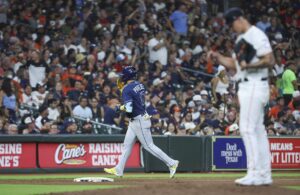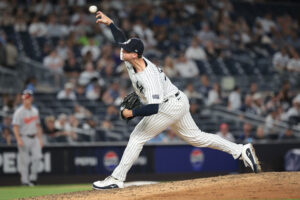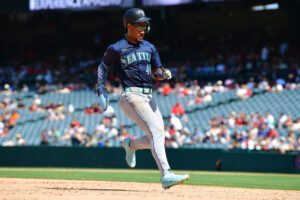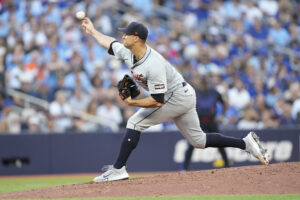It’s no secret that the New York Mets are desperate for arms. With 12 open spots on the 40-man roster, many expect New York to be active this winter in acquiring pitching. While the Mets need both quantity and quality, David Stearns should not look to acquire any big name available. Moves made this offseason should not hinder the team’s chances to compete for a division in 2025 and beyond. With 2024 as a transitional year for the club, the Mets should not acquire these pitchers this winter.
Pitchers The Mets Should Avoid This Winter
Brandon Woodruff
Recent non-tendered pitchers fresh off serious shoulder surgery are not typically hot commodities. However, that’s not the case for Brandon Woodruff. The 30-year-old will miss most, if not all, of 2024. However, teams like to sign someone in his position to a two-year deal, hoping he fully rebounds in 2025. Any innings pitched in 2024 would be gravy.
The Mets should not acquire this pitcher for two reasons. First, the team needs innings in 2024, not 2025. The rotation currently consists of just two reliable starters and three unproven options. One year from now, the Mets should have five of their top 20 prospects (per MLB) ready to contribute to the 2025 big league rotation. They will join Kodai Senga, the aforementionedmost free-agent three unproven options, and potential 2024 off-season acquisitions (maybe Yoshinobu Yamamoto).
After being non-tendered last week, Brandon Woodruff has reportedly drawn interest from a majority of MLB teams.@jonmorosi takes us through how the market is shaping up for the free agent right-hander. #MLBNHotStove pic.twitter.com/zPoFB29huJ
— MLB Network (@MLBNetwork) November 20, 2023
The Mets need arms right now, and Woodruff can’t provide that. Additionally, by the time Woodruff is ready to contribute fully- assuming no setbacks- the Mets might be better off signing a free agent like Corbin Burnes or Gerrit Cole (if he opts out).
Secondly, the Mets should not acquire Woodruff because there likely won’t be much value in his potential contract. Woodruff reportedly has a big market that could push a possible contract to the two-year, $30 million range. Teams do this type of deal to get the pitcher for below market value in year two. Heavy competition on the free agent market likely inflates his contract to a point where enough value disappears.
The Mets are not all-in on 2024 and, thus, should spend that money elsewhere. $30 million should be spent on arms that can pitch in 2024 and either get flipped at the deadline or be reliable pitchers for 2025-26. The Mets are not positioned to take the gamble on Woodruff.
Tyler Glasnow
Unlike Woodruff, Tyler Glasnow is healthy and on track to contribute in 2024. However, he is a pitcher the Mets should not acquire due to his injury history, contract status, and acquisition cost.
Glasnow just turned 30, yet already has a lengthy injury history. He can’t be counted on to make it to Opening Day healthy, let alone get through the entire season. That said, he produces at such a high level that teams are willing to have him on the roster. He might not make 30 starts, but his great production, even in just 20, significantly elevates a team’s potential.
Tyler Glasnow would be the best "stuff' starting pitcher the Cubs have ever had.
– Curveball: 80/80 (21% usage)
– 4seam: 65/80 (44%)
– Slider: 63/80 (35%)Here's Glasnow's curveball: pic.twitter.com/qke5WE7kE9
— Brendan Miller (@brendan_cubs) November 28, 2023
However, the Mets should not acquire Glasnow because he has one year of control and will cost a lot in a trade. Someone with this profile fits a team with 2024 World Series aspirations. That’s not the Mets. New York is emphasizing organizational depth throughout the system. Trading for Glasnow will deplete the depth (which isn’t great to begin with) and won’t be meaningful enough to improve the team’s competitiveness. If the Mets trade away young players, they must acquire players with multiple years of control.
One could argue that the Mets should take advantage of the Rays’ financial situation. New York can absorb Glasnow’s $25 million salary plus another contract (like the $12 million owed to Manuel Margot, a veteran the Mets were linked to a few weeks ago). This trade structure would lower the player package heading to Tampa Bay. The Mets could also recoup some of the depth by flipping them at the deadline or getting a Qualifying Offer draft pick if Glasnow leaves after the season.
However, this plan goes down the tubes if Glasnow suffers another serious injury. A trade features too many moving parts and uncertainty for the Mets.
What Pitchers Should the Mets Focus On?
Any move the Mets make this offseason, no matter the position, should help the 2025 squad and beyond. The Mets are not one or two players away from World Series contention. However, they have acquired enough young talent that, if they develop, can nicely supplement the existing core of star players. 2024 should be a season where the development of those players, both in the majors and minors, is emphasized.
Plenty of pitchers available via trade and free agency will be difference makers in 2025-27, not just 2024. The Mets must target one or two of these arms that don’t come with a huge cost. They can then complete the rotation with one or two bounce-back candidates on short-term deals that will ideally have value at the trade deadline. Any dollar that Steve Cohen spends this winter should easily be able to help future Mets teams, not just the 2024 squad.
Main Photo Credits: Rich Storry-USA TODAY Sports






